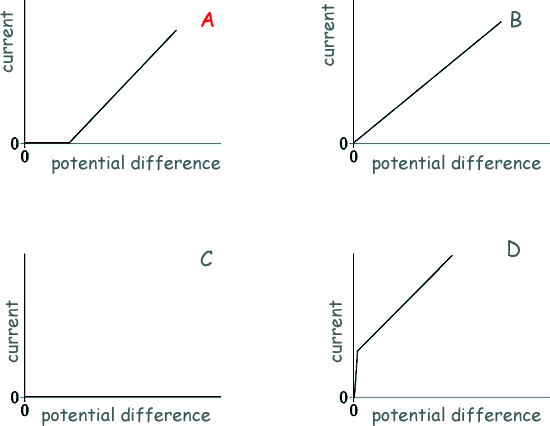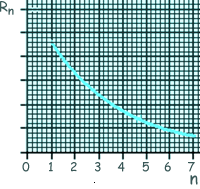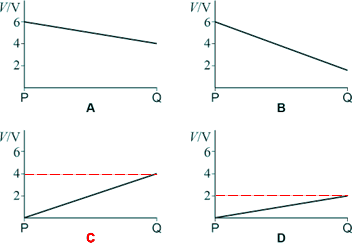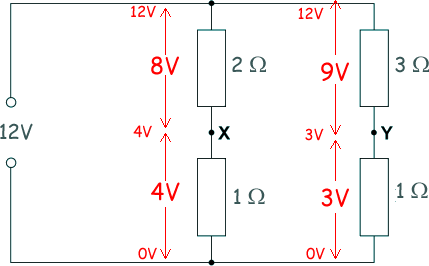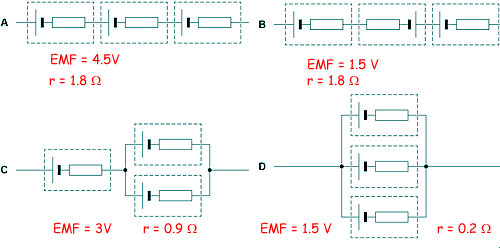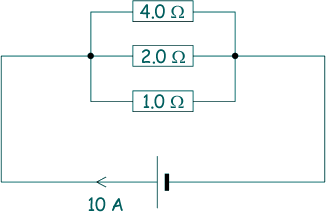Electricity - Multiple Choice Q1. A battery is connected to a 10 Ω resistor and a switch in series. A voltmeter is connected across the battery. When the switch is open (off) the voltmeter reads 1.45 V. When the switch is closed the reading is 1.26 V. What is the internal resistance of the battery?
EMF = 1.45 V V = 1.26 V R = 10 Ω V = IR 1.26 = I x 10 I = 0.126 A Lost volts = 1.45 - 1.26 = 0.19 V Vlost = Ir 0.19 = 0.126 x r r = 0.19/0.126 r = 1.5 Ω - choice D
Q2. The current in a wire is 20 mA. How many electrons pass a point in the wire in 2 minutes?
t = 2 minutes = 2 x 60s = 120 s I = 20 mA = 20 x 10-3 A Q = It Q = 20 x 10-3 x 120 C charge on an electron = 1.6 x 10-19 C Number of electrons = 20 x 10-3 x 120 /(1.6 x 10-19 ) Number of electrons = 1.5 × 1019 (choice B)
Q3. A resistor and diode are connected in series with a variable power supply as shown in the diagram.
Which best shows the characteristic for the combination of the resistor and diode?
Q4. A cell C of negligible resistance and a switch are in series with a resistor R.
The switch is moved to the on (closed) position for a time t. Which change reduces the amount of charge flowing through R in time t?
Q5. The National Grid uses high-voltage transmission lines to carry electrical power around the UK. A particular transmission line delivers 800 MW of power at 132 kV to the user. It loses 1% of the transmitted power as heat. What is the resistance of the transmission line?
P = IV = I2R = V2/R power loss = 1% 99% of transmitted power = 800 MW so, 1% = 8.1 MW Voltage sent originally is 132/0.99 kV 1% of it is 1330 V
Now, R = V2/P R = (1330)2/(8.1 x 106) R = 0.22 Ω - Choice A Q6. A potential divider circuit consists of a battery connected across a thermistor and variable resistor in series. Which of the following causes the potential difference (pd) across the thermistor to increase?
Q7. A student investigates how the potential difference V across the terminals of a cell varies with the current I in the cell. Which graph correctly shows how V varies with I?
EMF = I (r + R) EMF = Ir + V EMF of the cell is constant, as is 'r'- so as I increases V decreases Q8. In the circuit below, the potential difference across the light emitting diode (LED) is 1.8 V when it is emitting light.
The current in the circuit is 20 mA. What is the value of the resistor R?
EMF = 5V 1.8V is across the LED ∴ 3.2 V is across the internal resistance r and external resistance R I = 20 x 10-3A lost volts = Ir = 20 x 10-3x 10 = 0.20 V Therefore there is a potential drop of 3.0 V across resistor R V = IR R = V/I R = 3.0/(20 x 10-3) R = 150 Ω Choice C Q9. The combined resistance of 'n' identical resistors connected in parallel is Rn. Which statement correctly describes the variation of Rn as 'n' increases?
The relationship is not linear.
Q10. The table below shows the resistivity, length and cross-sectional area of wires P and Q.
The resistance of wire P is R. What is the total resistance of the wires when they are connected in parallel?
R = ρ l /A Resistance of wire P = R Resistance of wire Q = R x ¼ x 2 = R/2 1/RTOT = 1/RP + 1/ RQ 1/RTOT = 1/R + 2/R = 3/R ∴ RTOT = R/3 Choice B Q11. The circuit shown is used to supply a variable potential difference (pd) to another circuit.
Which graph shows how the pd supplied V varies as the moving contact C is moved from position P to position Q?
Therefore the answer must be C or D
Choice C is therefore correct.
Q12. In this resistor network, the emf of the supply is 12 V and it has negligible internal resistance.
What is the reading on a voltmeter connected between points X and Y? 4V- 3V = 1V
Q13. Kayjay carries out an experiment to determine the resistivity of a metal wire. She determines the resistance from measurements of potential difference between the ends of the wire and the corresponding current. She measures the length of the wire with a ruler, and the diameter of the wire using a micrometer. Each measurement is made with an uncertainty of 1% Which measurement gives the largest uncertainty in the calculated value of the resistivity?
ρ = RA/L but A ∝d2 ∴ the d measurement has double the effect on uncertainly of resistivity (See the page on uncertainties) Q14.The mean power dissipated in a resistor is 47.5 µW when the root mean square (rms) voltage across the resistor is 150 mV. What is the peak current in the resistor?
P = IV 47.5 x 10-6 = I x 150 x 10-3 I = 47.5 x 10-6/150 x 10-3 IRMS = 3.17 x 10-4 A IPEAK = IRMS x √2 IPEAK = 3.17 x 10-4x √2 IPEAK = 4.48 x 10-4 A Choice B Q15. The National Grid is used to transfer electrical energy from power stations to consumers. What conditions for the transmission voltage and the transmission current give the most efficient transfer of energy through the National Grid?
High voltage and low current as electrical to heat energy transfer to the atmosphere = I2R
Q16. A mains transformer has a primary coil of 2500 turns and a secondary coil of 130 turns. The primary coil is connected to a mains supply where Vrms is 230 V. The secondary coil is connected to a lamp of resistance 6.0 Ω. The transformer is 100% efficient. What is the peak power dissipated in the lamp?
The step down transformer will drop voltage 2500/130 Output voltage RMS = 230 x 130/2500 = 12 V VPEAK = VRMS √2 VPEAK = √2 x 12 = 17 V V = IR I = V/R = 17/6 = 2.8 A P = IV P = 17 x 2.8 P = 48 W Choice C
Q17. Three cells each have an emf ε = 1.5 V and an internal resistance r = 0.6 Ω. Which combination of these cells will deliver a total emf of 1.5 V and a maximum current of 7.5 A?
I = EMF/r A - 4.5/1.8 = 2.5 A B - 1.5/1.8 = 0.83 A C - 3/0.9 = 3.33 A D - 1.5/0.2 = 7.5 A Choice D Q18. The current in the cell is 10 A as shown in the diagram.
What is the current in the 2.0 Ω resistor?
V = IR V/R = I I = V/R V/RTOTAL= 10 amps V/RTOTAL= V/4 + V/2 + V/1 = 10 ¼ + ½ + 1 = 10/V 1.75 V = 10 V = 10/1.75 = 5.71 V/R2 = I2 I2 = 5.71/2 = 2.86 A OR - a reasoning method.... Current through the 2.0 Ω is double that through the 4.0 Ω and half that through the 1.0 Ω one total current = I2 (1 + 0.5 + 2) = 3.5 I2 = 10 amps I2 = 10/3.5 I2 = 2.86 A Choice B Q19. A battery of negligible internal resistance and an emf of 12 V is connected in series with a heating element. The heating element has a resistance of 6.5 Ω when in operation. What is the energy transferred by the heating element when operating for 5 minutes?
P = IV but V = IR and I = V/R so P = V2/R P = 122/6.5 P = 144/6.5 = 22.15 W 22.15 W = 22.15 J/s 5 minutes = 5 x 60s = 300 s Energy in 5 minutes = 22.15 x 300 = 6645 J Choice C Q20. Which statement about superconductors is correct?
Q21. A wire has a resistance R. What is the resistance when both the length and radius of the wire are doubled?
R = ρL/A doubling the length increases resistance by a factor of 2 doubling the radius increases the csa by a factor of 22 increasing the csa by a factor of 4 makes resistance drop by a factor of 4 Therefore overall the resistance drops by a factor of 2 Choice B |
Follow me...
|



